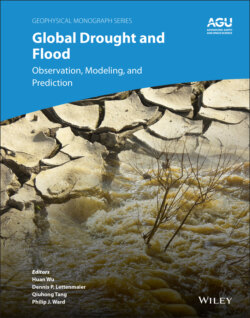Читать книгу Global Drought and Flood - Группа авторов - Страница 51
3.5. DISCUSSION AND CONCLUSIONS
ОглавлениеRemotely sensed reservoir data have the potential of being used with other drought indicators jointly to promote improved drought mitigation.
First, by combining the remotely sensed reservoir storage information with GRACE terrestrial water storage anomalies, optimal use of surface water and groundwater in combination would be feasible. In light of the ever‐increasing water needs and the uncertain supplies, leveraging water resources and increasing water use efficiency, including both surface water and groundwater, will be key for sustaining population growth and agricultural production in the 21st century. However, the existing GRACE‐based drought indicators examine only the total storage anomalies (Long et al., 2013; Thomas et al., 2014). A recent study has found that the drought index based on reservoir area can help fill the information gap between streamflow/runoff‐based and groundwater‐based drought indices (Zhao & Gao, 2019b). By integrating a surface water storage component, the joint management of surface water and groundwater can be achieved. For instance, Tang et al. (2010) have shown that subtracting reservoir storage changes from GRACE water storage anomalies could provide better support for water resources management purposes.
Second, a holistic examination of meteorological, agricultural, and hydrological drought indicators is crucial for purposes of mitigating socioeconomic drought. With reservoir inflow driven by precipitation and release determined by water demand, a reservoir drought index can meaningfully link meteorological drought with socioeconomic drought. It is worth noting that a given reservoir drought index is a function of inflow, evaporation, and release. While inflow and evaporation are primarily affected by meteorological drought, release is primarily used for flood control and/or meeting downstream water demand. For reservoir operation optimization under drought conditions, the trade‐offs among agricultural, industrial, and municipal supplies are complicated and are closely tied to the socioeconomic benefits. In this sense, reservoir drought indices are hybrid in nature and uniquely different from the other types of indices. By comparing meteorological drought indices with given reservoir drought indices, the impacts on reservoir storage from natural drought and human usage can be partitioned. Under the pressing situation of nonstationarity (Milly et al., 2008), a decreasing trend of reservoir storage/area/elevation could be triggered by the combination of drought and increased water use (e.g., from the growing population).
In summary, several conclusions can be drawn from this chapter. (a) Remote sensing of reservoir data offers a unique promise for monitoring hydrological drought from space. Due to the shortage of streamflow and reservoir measurements, satellite observations of surface water are invaluable. (b) Reservoir storage is deemed to be the best indicator of drought severity, as compared to elevation and area. However, such data are available only for a small portion of reservoirs globally, limited by the availability of altimetry measurements. (c) Reservoir area data, which have better spatial and temporal coverage than elevation/storage data, can be used to derive a drought index suitable for monitoring purposes at local and regional scales. (d) By fusing observations collected by past, current, and future satellite missions, storage monitoring of most global reservoirs will be feasible. (e) The skills of hydrological‐modeling‐based drought monitors can be enhanced by incorporating remotely sensed reservoir information.
